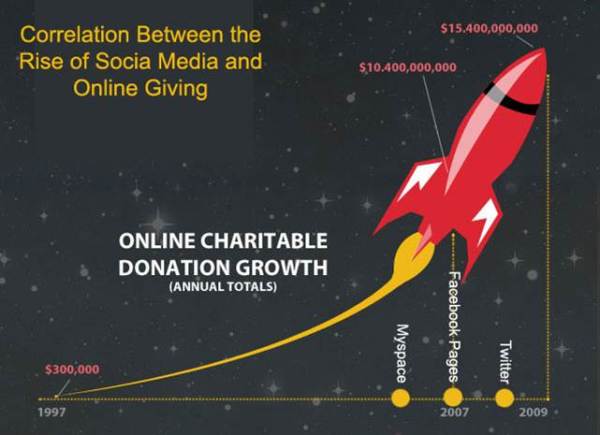Don’t Think Social Media Results in Online Donations? Think Again!
 Source: Social Good: Charity and Technology in the Online Universe
Source: Social Good: Charity and Technology in the Online Universe
 Written for the March 2011 issue of Fundraising Success Magazine, where I am writing a quarterly column throughout 2011.
Written for the March 2011 issue of Fundraising Success Magazine, where I am writing a quarterly column throughout 2011.
* * * * * * * * * * *
In the summer of 2000, I launched an e-advocacy portal called eActivist.org. It was a fiscal project of the Tides Center, and I was able to operate and fundraise like any other 501(c)(3). Back then, the launch of “Donate Now” technology in 1997 and its potential to transform philanthropy was all the buzz — much like social media today.
Like other early adopters of the day, I was more than eager to pay the $200 Donate Now account sign-up fee and high donation-processing rates. Donate Now buttons were perhaps the most exciting “Next Big Thing” to hit to charitable giving in decades, if not ever.
Well, imagine my — rather our — disappointment when we discovered that simply having a Donate Now button on your website didn’t result in thousands of dollars in monthly donations. In fact, I think the first month I hit $100 in total donations was a much celebrated benchmark. Many of us just assumed that donors, especially younger ones, would automatically convert their giving from using checkbooks to credit cards. We were wrong. It took almost a decade for online giving to reach just 5 percent of all giving in the United States.
We discovered almost immediately that donors were going to need some time to get accustomed to giving online. Many donors feared the new technology — that their credit card accounts would get hacked or their personal financial information stolen. As a result, we spent the next 10 years crafting our print and Web materials to soothe those fears, and as of today, I’d say we were successful. Young people are mostly perplexed by the idea of writing checks, and 25 percent of those 65 and older now donate online. Across all generations, online giving is now more common and the fear mostly subsided.
However, in those early years we also realized pretty quickly that online donors didn’t just stumble upon your website on the Information Superhighway. Rather, they needed to be presented with a great, big, flashy exit sign to “Donate Now,” which gave rise to the all-powerful e-newsletter. Nonprofit fundraisers spent the first decade of the 21st century perfecting e-mail communications and fundraising. To this day — but for how much longer no one knows — a click in an e-newsletter is still the greatest source of traffic to your Donate Now page and by far the most successful means to raise dollars online.
And so it goes with social media
What does all this have to do with social media? Everything! Look carefully at the infographic above. Notice how online giving starts to grow around 2006? Well, that’s when nonprofits started using MySpace to engage the MySpace community. But if they were strategic, they also used it to build their e-newsletter lists and drive traffic to their Donate Now pages.
Notice the larger jump in giving in 2007? Guess what happened that year? Facebook Fan Pages were launched late in 2006 and grew by the millions in the nonprofit sector throughout 2007 to the present. One out of every two Americans now uses Facebook regularly, and that has dramatically resulted in increased brand recognition and website traffic for nonprofits — at least for those that know how to use it correctly. What about Twitter? It soared in users beginning in 2008 to present.
Working hand in hand
Is it just a coincidence that online giving skyrocketed in direct correlation with the rise of social media? I don’t think so. Not at all.
In fact, social media is finally helping Donate Now technology reach its full potential. All the hopes and buzz that we were writing, e-mailing and talking about in 2000 are now transforming into real dollars raised online. And anyone who regularly monitors the Blackbaud Index of Online Giving or Network for Good’s Online Giving Index knows we’re about to blast off in online giving. The total dollars raised annually by the nonprofit sector is on a current path to grow exponentially year after year and likely will not move backward until mobile giving becomes the dominant means of processing charitable donations.
That said, nonprofits that have been utilizing social media for two years to six years are now the best positioned to reap the benefits of Donate Now technology. Similarly, those that are now pioneering mobile technology will be the best positioned to reap the benefits of mobile giving in years to come. That’s just the way the Web works now — fortune befriends the early adopters.
Many nonprofits have concluded prematurely that social media does not directly contribute to online dollars raised because amounts given through Facebook, Twitter or MySpace apps and widgets have been relatively low. But that conclusion misses the bigger picture of what’s really happening. It took almost a decade for donors to trust Donate Now technology. Similarly, it might take years for them to trust apps and widgets (and mobile-giving technology), but can you imagine if we had listened to the naysayers and thrown out Donate Now buttons in 2005 because the results weren’t immediate?
Granted, it’s almost impossible to track where your online donors come from unless you specifically poll them after they donate online. But any good social-media manager that is invested in and engaged with an organization’s online communities and is in tune with the ebb and flow of online behavior knows that the secret of the Social Web is to utilize it to both build the organization’s online brand recognition and its e-newsletter and (now) mobile lists.
Related Links:
Webinar: How Nonprofits Can Successfully Utilize Online Fundraising and e-Newsletters
Social Media for Social Good: A How-To Guide for Nonprofits





I think there’s a definite space for social outreach to take the place of newsletter lists. It’s much easier to be much more personal.
I read in a blog post ( http://bit.ly/lyPLM8) on Chronicle of philantropy that 90% of nonprofits are engaging in social media of some sort, BUT the post also stated that 18% of those orgs saw no impact from using it. I thought HOW could that be the case! The only explanation I can think of is improper use of social media and/ or not understanding how to truly use it.
This is an awesome post, Heather. At Jolkona (http://www.jolkona.org), the nonprofit I work for, we only speak in online donations. Since launching two years ago, we’ve received $130K in donations for projects through our site. In other claims to fame, we raised $10K in micro-donations for women’s empowerment projects during Women’s History Month last March, this campaign was promoted through social media alone (blog recap of campaign: http://bit.ly/qQH5QV).
I think what you’re getting at is you can’t just put up a “Donate Now” button and expect that people will show up, you have to have a strategy behind it to drive traffic, engagement, etc. It’s the same secret sauce for social media — you can’t just toss up a Twitter profile or a Facebook Page and expect people will come, you have to give them a reason for it. It’s community management 101 but you need a community manager to implement the strategy and make it happen.
Laura Kimball
Director of Communications & Social Media, Jolkona
http://www.jolkona.org
Very interesting addition to the way we think about social media. Metrics deal with direct donations from Facebook etc. but not the traffic they drive to websites that generates donations. It is indirect but nonetheless valuable.
Great post. The comment from “Mindframe” above hit the nail on the head. It’s HOW organizations are using social media. For example, lots of nonprofits don’t thank their twitter followers for retweets, or engage them on any level. Our nonprofit, seeyourimpact.org, embraces this, and the response has been tremendous. You have to engage on LinkedIn, and provide fresh content and questions on Facebook.
Social media should not be “the tool” but one of many tools that you use. And when used consistently and effectively, the results can be beneficial.